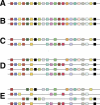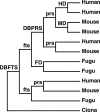Two rounds of whole genome duplication in the ancestral vertebrate
- PMID: 16128622
- PMCID: PMC1197285
- DOI: 10.1371/journal.pbio.0030314
Two rounds of whole genome duplication in the ancestral vertebrate
Abstract
The hypothesis that the relatively large and complex vertebrate genome was created by two ancient, whole genome duplications has been hotly debated, but remains unresolved. We reconstructed the evolutionary relationships of all gene families from the complete gene sets of a tunicate, fish, mouse, and human, and then determined when each gene duplicated relative to the evolutionary tree of the organisms. We confirmed the results of earlier studies that there remains little signal of these events in numbers of duplicated genes, gene tree topology, or the number of genes per multigene family. However, when we plotted the genomic map positions of only the subset of paralogous genes that were duplicated prior to the fish-tetrapod split, their global physical organization provides unmistakable evidence of two distinct genome duplication events early in vertebrate evolution indicated by clear patterns of four-way paralogous regions covering a large part of the human genome. Our results highlight the potential for these large-scale genomic events to have driven the evolutionary success of the vertebrate lineage.
Figures







References
-
- Ohno S. Evolution by gene duplication. Berlin: Springer-Verlag; 1970. 160 pp.
-
- Lander ES, Linton LM, Birren B, Nusbaum C, Zody MC, et al. Initial sequencing and analysis of the human genome. Nature. 2001;409:860–921. - PubMed
-
- Venter JC, Adams MD, Myers EW, Li PW, Mural RJ, et al. The sequence of the human genome. Science. 2001;291:1304–1351. - PubMed
-
- Lundin LG. Evolution of the vertebrate genome as reflected in paralogous chromosomal regions in man and the house mouse. Genomics. 1993;16:1–19. - PubMed
-
- Meyer A, Schartl M. Gene and genome duplications in vertebrates: the one-to-four (-to-eight in fish) rule and the evolution of novel gene functions. Curr Opin Cell Biol. 1999;11:699–704. - PubMed

